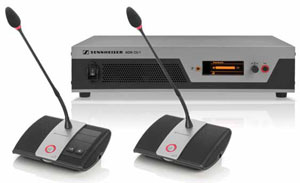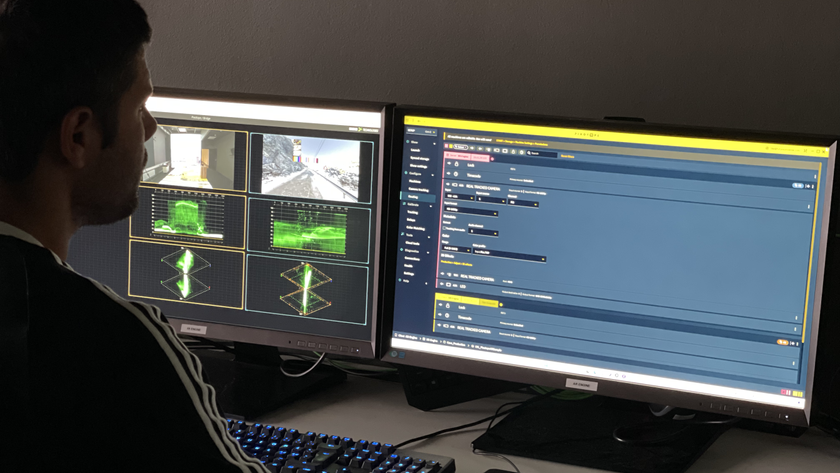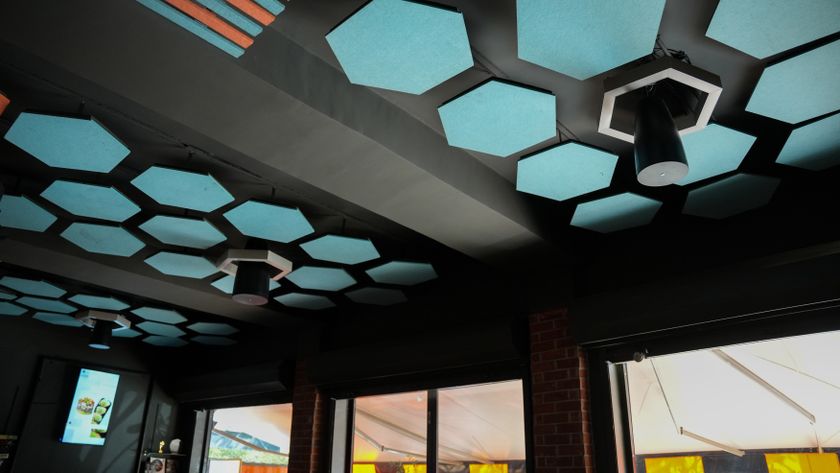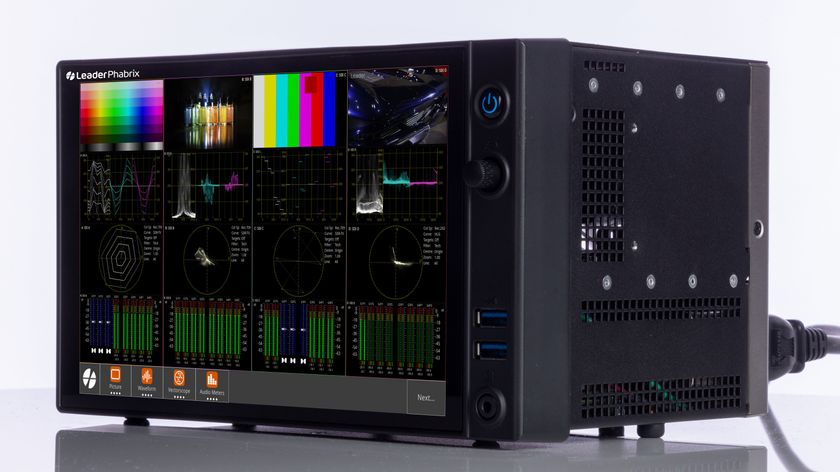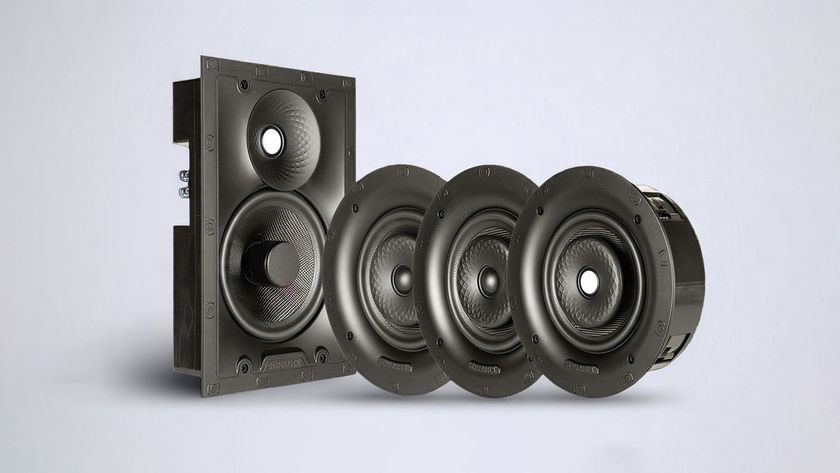Conference Mic Systems Gain Traction in the U.S. Market
Sennheiser ADN
A longtime stalwart in European systems integration, conference microphone systems have recently gained a stronger toehold in the U.S. market.
“The market for conference systems has exploded in recent years, which has led to the development of a number of new conferencing systems,” said Mark Donovan, Audio-Technica sales engineer.
Brooks Gibbs, conferencing product group leader for Listen Technologies, echoed this sentiment. “Conference microphone systems have been widely used outside of the North American market and now are seeing tremendous acceptance and growth.”
The biggest technology trends in these new products include wireless, infrared, and portability features, which when combined with wired and installed system offerings, create many options for integrators, according to Michael Tremain, assistant applications specialist, central region, Bosch U.S.
Initially, the concept of point-to-point conferencing versus internal in a given room “was a little foreign to many [integrators],” Tremain noted. “Even though it was hard for them to get out of this mindset, we’re gaining significant momentum.”
New options provided by the equipment are also inspiring the adoption of these solutions. “Wireless technologies are allowing the use of conferencing system in environments where customers have been very hesitant to install a wired system,” Gibbs observed.
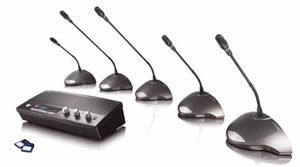
Bosch CCS 900 Ultro
Improved intelligibility is another advance that is opening new markets in the United States. “Our approach is one that essentially takes the room out of the equation, and that’s always been a problem with traditional systems where you need complex DSP and setup is not always easy,” Tremain said. “In our system, each user has a speaker, or headset, and microphone in his console. This shortens the critical distance from the user to the speaker and the microphone, and thus eliminates the need for a lot of equalization, mix-minus type of DSP.”
The acoustical challenges posed by large groups utilizing traditional public address and microphone systems are also solved by these new conference microphone systems, Gibbs said. “Conference microphone systems create an excellent solution for acoustically challenging environments by creating personal communication spaces for each participant.”
This solution to what Gibbs referred to as “acoustical chaos,” has opened more applications in colleges where large lecture halls are used. “Conference microphone systems create an environment in these lecture halls where there is no back of the classroom; all students can hear and participate in the lecture or discussion equally,” he elaborated. “Similarly, conferencing microphone systems are being placed in corporate training and presentation rooms, assisting in better communication and participation.”
Other new conference mic features are opening up additional vertical markets. A new feature of TAIDE N systems is individual gain control and EQ for each microphone. “This opens up the U.S. court market,” said Fardad Zabetian, CEO of MediaVision, TAIDE N’s U.S. distributor.
Platforms that can record and store spoken communication are useful in the courtroom application, Gibbs also noted. Secure voting features Bosch offers are also useful in legislative environments.
Another intelligibility feature of TAIDE N’s is an eight-output system, which can create different zones in a large room. Zabetian gave the example of a classroom with 60 microphones that can be divided into six or eight zones. This helps cancel echoing and delay, as well as lowering the volume of ceiling speakers, minimizing feedback. “Sound designers really like this feature,” Zabetian said.
One trend sparking demand for conference systems involves more flexible, multi-purpose rooms, Donovan noted. “They will use a space as a boardroom one day and a classroom the next, then they may divide the room up to provide multiple small meeting or conference rooms.”
The hospitality market is another new growth opportunity. “Large hotel and convention centers are using the conference systems as a part of their rental services to their customers,” Gibbs said. “These systems provide solutions to conferences, educational training, forum discussions, and multiple language interpretation support of conference meetings.”
Tremain agreed: “That it can be rented is kind of a new market that expands the use of conference systems beyond what we have done in the past.”
Other areas of business also benefit from these new technologies. Audio-Technica’s ATCS-60 and SpectraPulse systems address security issues, which is useful to hospitals subject to HIPAA guidelines and corporate clients that require security compliance, Donovan said.
As systems continue to evolve, the issue of future proofing installations is a factor manufacturers like Sennheiser consider in product development. “As technology advances, remote conferencing, and integration with web-based networks will continue to impact the landscape of conference systems,” said Vanessa Jensen, senior product specialist, systems integration, Sennheiser. “The ADN system was designed to readily adapt to future technologies, allowing integrators and end-users to remain on the cutting edge of new solutions. The Feature Release I is a recent example of updates to the system, expanding the system support of new technologies in conference applications.”
Lindsey Snyder is assistant editor at SCN.
AKG CS 5

With the AKG CS 5, users can design high-level conference systems complete with ID card identification. It has one-, three-, and five-step voting, interpretations of up to 63 languages, and infrared distribution of up to seven languages. The necessary infrared components are built into the base unit, enabling direct connection of the CS 5 radiators, CS 5 IRT1 and 2. With the CS 5 BU unit, up to 5,000 participant and interpreter units can work in one big system. The CS5 BU also acts as an interface to all external devices, including: mixers, wireless microphones, recording devices, CD players, and more.
Sennheiser ADN
The updated operating software for the ADN discussion system from Sennheiser includes various modes to ensure more convenient system handling and to enhance speech intelligibility in acoustically difficult conference situations. The software is now available in 13 languages and can be downloaded free from the Sennheiser website. The new software enables the central unit of the ADN system to communicate directly with media control devices via an open protocol, allowing it to be integrated into existing AV control systems. The XLR mix-minus mode improves the audio quality at conferences that take place at more than one location. The mic loudspeaker mute mode ensures that the speaker’s own contributions are only transmitted to the external participants and not through the loudspeaker of the terminals. Only the voices of the external participants are played through the loudspeakers.
Audix MicroPods
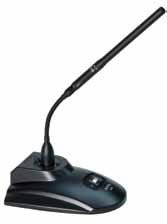
Audix MicroPods consist of 6-inch, 12-inch, and 18-inch goosenecks with either a M1250B cardioid, hypercardioid, or supercardioid capsule incorporated into the system. These goosenecks feature mini-XLR connectors to interface with the microphone, allowing for instantaneous exchanges to be made between any of the microphones in the Micros series. The other end of the gooseneck is a standard XLR-M connector, which can be utilized with any standard XLR-F receptacle or microphone cable. Designed as a problem solver for the professional contracting and installation market, the MicroPods are generally used in conjunction with either the ATS10 base, with on-off lighted switch, ATS1 base with programmable switch, or the ATS1-Logic base with programmable switch and remote logic functions.
TAIDEN HCS-8313
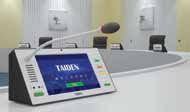
With the entire standard feature set of a conference system delegate, the TAIDEN HCS-8318 offers a 10-inch touchscreen interface for the meeting participant to manage presentation material. The units come with various options that will eliminate the need for laptops in the boardroom, council chamber, or courtroom. Multimedia content is shared with the terminals through a daisy-chained Cat-6 cabling design. Up to 30 units can be run together per homerun and thousands can be connected to one system. Video files can be shared over the system, and TAIDEN video encoders can push live video signals to the terminals as well using the gigabit ethernet network.
Bosch CCS 900 Ultro
The CCS 900 Ultro is an all-in-one discussion system designed and developed by Bosch. The patent-pending possible-to-speak function provides visual indication when the microphone is available for a delegate to take the floor. The CCS 900’s speech intelligibility is ensured by Bosch’s DAFS (Digital Acoustic Feedback Suppressor) technology, which is built into the central unit. The CCS 900 enables users to both listen back to proceedings and participate directly in discussions. The control unit has a built-in MP3 recorder to record and play back. It can record up to 64 hours of discussion using a 2-gigabyte SD card. It also features a 60-second buffer.
beyerdynamic Stegos
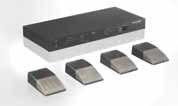
The new wireless boundary microphones from beyerdynamic’s Stegos product line convert the spoken word into a digital signal and transfer it to a single receiver. Depending on the size of the room and the number of participants, up to four microphones can be used. This transfer takes place using secure spread spectrum processing technology with additional 128-bit encryption. Up to three systems can be used simultaneously in parallel. The environmentally friendly, disposable NiMH battery pack allows the system to operate for 14 hours.
Listen DC 6990 P
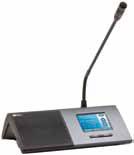
The DC 6990 P from Listen is a fully digital portable conference unit for permanent or temporary meetings with speech, voting, and/or language interpretation functions. The unit features a builtin loudspeaker, a three-pin XLR connector for a pluggable gooseneck microphone sold separately, two channel selectors, two microphone buttons, and a 3.5-inch high-resolution color touchscreen. The touchscreen can be customized for one or two meeting participants to log in and view text written in their own language, vote, and select an interpretation listening channel. The user also has the ability view the active speaker list, agenda, or voting results.
Audio-Technica ATCS-60 IR
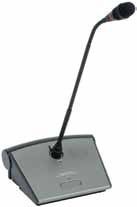
Audio-Technica’s ATCS-60 IR conference system is a fully selfcontained wireless distributed audio system designed for corporate, government, and educational applications. The modular voting unit features a five-button configuration can be programmed to allow up to five options, useful when multiple candidates are standing for election. Up to 150 voters can be handled by an ATCS-60 system using ATCS-V60 modules. The system also features simultaneous interpretation for one native language and up to three foreign languages; automatic camera tracking to follow the switching of microphones; optional minutes recording; along with other features that help improve conference efficiency.
